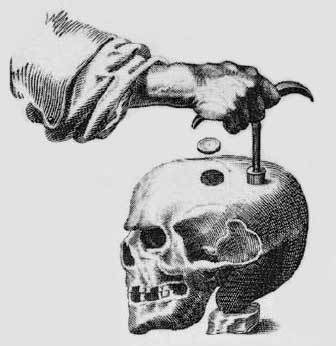Boring skulls since 1617
“There are lots of good reasons for making a hole in someone’s head, and in a neurosurgeon’s hands it is not a risky procedure, but for someone doing it themselves the risks are huge.”
 This advice, from the British Medical Journal (BMJ, 320(7235): 602.), is very probably as sound today as when it was published in March 2000. For those who want to read more about the history of cranial boring (self-drilled and otherwise) look no further than the definitive book by Charles G Gross, ‘A Hole in the Head : More Tales in the History of Neuroscience’, 367 pages, The MIT Press, 2009. Significant extracts of which may be found here.
This advice, from the British Medical Journal (BMJ, 320(7235): 602.), is very probably as sound today as when it was published in March 2000. For those who want to read more about the history of cranial boring (self-drilled and otherwise) look no further than the definitive book by Charles G Gross, ‘A Hole in the Head : More Tales in the History of Neuroscience’, 367 pages, The MIT Press, 2009. Significant extracts of which may be found here.
Note:
The picture above is a detail from an illustration plate found in some editions of :
THE SVRGIONS MATE, OR, A TREATISE DISCO-uering faithfully and plainely the duecontents of the SVRGIONS Cheft : the ufes of the Instruments, the vertues and operations of themedicines, the cures of the moft frequent difeases at SEA:Namely, Wounds, Apoftumes, Vlcers, Fiftulaes, Frac-tures, Diflocations, with the true maner of Amputation,the cure of the Scuruie, the Fluxes of the belly,of the Collica and Illiaca Passio, Tenafmus,and exitus Ani, the Callenture;WITH A BRIEFE EXPLANATIONof Sal, Sulphur, and Mercury; with certaine Characters, and tearmes of Arte.’Penned in 1617 by svrgion surgeon, barber and cranial-drill inventor John Woodall (c.1570 – 1643).

Marc Abrahams's Blog
- Marc Abrahams's profile
- 14 followers





